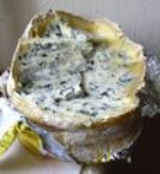
Fourme d'Ambert
Encyclopedia
Fourme d'Ambert is one of France
's oldest cheeses, and dates from as far back as Roman times
. It is a usually pasteurized cow's milk blue cheese
from the Auvergne
region of France
, with a distinct, narrow cylindrical shape.
The semi-hard cheese is inoculated with Penicillium roqueforti
spores and aged for at least 28 days.
Almost identical to Fourme de Montbrison
, the two were protected by the same AOC
from 1972 until 2002 when each was recognized as its own cheese with slight differences in manufacture. A likeness of the cheese can be found sculpted above the entrance to a medieval chapel in La Chaulme (Auvergne, France.)
Although most often produced with pasteurized milk by industry and Coopératives, more recently artisanal production has begun using raw milk, and farm or fermier production has now re-started, by the moment, three farmers produce up to 15 tonnes of fourme d'Ambert fermière AOP inevitably made with raw milk.
France
The French Republic , The French Republic , The French Republic , (commonly known as France , is a unitary semi-presidential republic in Western Europe with several overseas territories and islands located on other continents and in the Indian, Pacific, and Atlantic oceans. Metropolitan France...
's oldest cheeses, and dates from as far back as Roman times
Ancient Rome
Ancient Rome was a thriving civilization that grew on the Italian Peninsula as early as the 8th century BC. Located along the Mediterranean Sea and centered on the city of Rome, it expanded to one of the largest empires in the ancient world....
. It is a usually pasteurized cow's milk blue cheese
Blue cheese
Blue cheese is a general classification of cow's milk, sheep's milk, or goat's milk cheeses that have had cultures of the mold Penicillium added so that the final product is spotted or veined throughout with blue, blue-gray or blue-green mold, and carries a distinct smell, either from that or...
from the Auvergne
Auvergne (région)
Auvergne is one of the 27 administrative regions of France. It comprises the 4 departments of Allier, Puy de Dome, Cantal and Haute Loire.The current administrative region of Auvergne is larger than the historical province of Auvergne, and includes provinces and areas that historically were not...
region of France
France
The French Republic , The French Republic , The French Republic , (commonly known as France , is a unitary semi-presidential republic in Western Europe with several overseas territories and islands located on other continents and in the Indian, Pacific, and Atlantic oceans. Metropolitan France...
, with a distinct, narrow cylindrical shape.
The semi-hard cheese is inoculated with Penicillium roqueforti
Penicillium roqueforti
Penicillium roqueforti is a common saprotrophic fungus from the family Trichocomaceae. Widespread in nature, it can be isolated from soil, decaying organic matter, and plants. The major industrial use of this fungus is the production of blue cheeses, flavouring agents, antifungals, polysaccharides,...
spores and aged for at least 28 days.
Almost identical to Fourme de Montbrison
Fourme de Montbrison
Fourme de Montbrison is a cow's-milk cheese made in the regions of Rhône-Alpes and Auvergne in southern France. It derives its name from the town of Montbrison in the Loire department....
, the two were protected by the same AOC
Appellation d'Origine Contrôlée
Appellation d’origine contrôlée , which translates as "controlled designation of origin", is the French certification granted to certain French geographical indications for wines, cheeses, butters, and other agricultural products, all under the auspices of the government bureau Institut National...
from 1972 until 2002 when each was recognized as its own cheese with slight differences in manufacture. A likeness of the cheese can be found sculpted above the entrance to a medieval chapel in La Chaulme (Auvergne, France.)
Although most often produced with pasteurized milk by industry and Coopératives, more recently artisanal production has begun using raw milk, and farm or fermier production has now re-started, by the moment, three farmers produce up to 15 tonnes of fourme d'Ambert fermière AOP inevitably made with raw milk.

